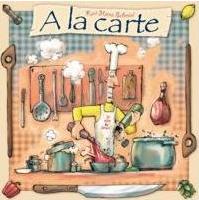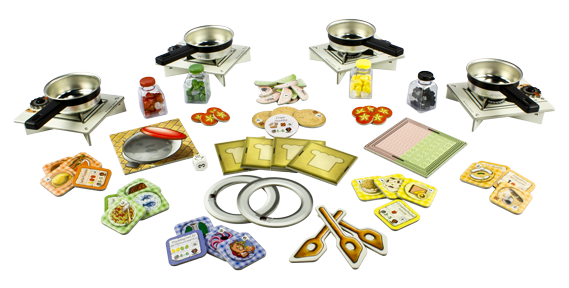
A la Carte
2-4
14+
30+

A la Carte is a game of dexterity and delicacies for 2-4 players.
Hone your culinary skills by adding spices and cooking your masterpiece to the perfect temperature. Be careful not to overspice or overcook your dish, because a ruined meal ends up in the garbage. This lighthearted cooking game by Karl-Heinz Schieml is sure to be a hit with the whole family.

images © Fantasy Flight
User Reviews (1)
Add a Review for "A la Carte"
You must be logged in to add a review.

Bottom Line Up Front: Dexterity and luck each factor heavily in the outcomes of A la Carte. The cooking theme comes through nicely and is always present. A good family experience that never seems to get too competitive (interestingly, it is unique among my games in that when I recall the various sessions I’ve played, I can rarely recall the actual winner). It is more like structured “play”. It is easy to have fun and recognize some absurdity, but conversely it also lacks any real “thrill of victory”. If you are looking at this as something solely for experienced adult gamers, it may not have enough meat to it to satisfy for any length of time. (That was a pun!)
COMPONENTS: The picture will reveal little stove and pan kitchen toys, spice bottles filled with colorful chunks of plastic, and all sorts of tokens and recipe cards. I like the toy pans. The spices and bottles are designed well. I wish the stovetops were higher quality (little tears in colored surface just from removing from cardboard stock sheets and temp dial can be a pain), but all of the items involved in the dexterity portions work. Young kids find it attractive and will come running when this is presented.
GAMEPLAY: Each player gets a cardboard model stovetop burner with temperature dial and a metal pan. The player chooses a recipe card (some may call it a recipe token, it’s a thick little square of cardboard; rather between a token and a card in my uneducated opinion) and places it into his pan. Each recipe requires the right amount of the four spices and the right cooking temperature. On the players turn he may choose three actions to complete the recipe according to instructions on the card. The three actions are typically some combination of rolling the custom die to increase the temperature some amount, or adding “spices” to their dish. The spice adding is the chief dexterity event. There are four spice bottles containing fifteen plastic spice chunks of a specific color as well as five transparent salt chunks. A player is allowed a single motion to add spice to the dish (no shaking or turning over the dish; just a single flip. The size, shape, and texture of the spice chunks can make it difficult to predict how many will come out. It is a nice design on the shaker opening size and shape of the chucks in that they jam up the mouth of the bottle nicely. Typically you see one or two pieces come out, often enough they all jam up and none hit the pan. The clear salt pieces don’t count as the proper spice. The correct amount of spice and correct temperature range scores the player points (more complicated dishes score more points). Too much spice, too much salt, or too high of a temp ruin the dish and no points are scored. A special crepe dish for each player offers an alternative dexterity event requiring a flip and catch using the pan. There are “special abilities” as to be expected; some die rolls earn you a “coffee cup” token with special abilities to help you or hurt your opponent. Completing three dishes flawlessly (no extra spice/exact temp) makes you an instant winner. If a player completes five dishes within tolerance (or you run out due to ruined dishes), the game stops and you tally up the points earned to determine the winner.
The spice bottle action and die rolling allows for a high level of randomness. While the rules may suggest to you that strategy comes into play in selecting optimal scoring recipes, any strategy is outweighed by dexterity and luck in deciding winners and losers.
SUMMARY: I’ll pass on the pros and cons list this time because most of the games unique characteristics could be considered either. A la Carte is a light game that fills a niche for me. I am glad I own it, but have no desire for more like this or any expansions. It’s a fun game for my family (two elementary school-aged children) and includes interesting components. To be fair this has worked for a group of adults, too. It has worked after completing more competitive games late at night and after a few drinks, when no one wants to keep score anymore.
Regards,